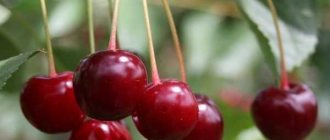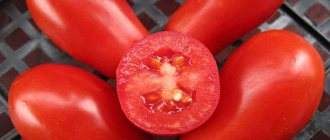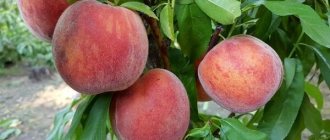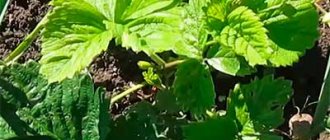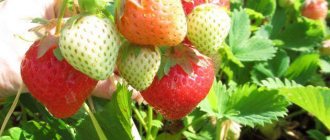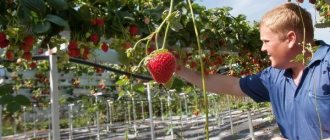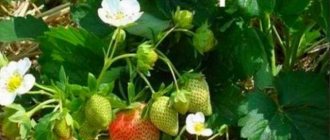Description of the strawberry variety Moscow delicacy
Remontant strawberry Moscow delicacy is a medium-sized hybrid. The bushes grow up to 40 cm. They take up little space due to the fact that the leaves are located close to the main stem, and the remontant nature of the Moscow Delicacy variety does not imply active root formation.
Botanical description:
- leaves – green, wide with slight pubescence;
- the stems are dense, light green, with thin petioles;
- the root system reaches 7 cm, is developed in both directions, and is symmetrical;
- inflorescences of both sexes are located under the leaf blades;
- the berries have the shape of cones with a blunt end, the average weight of the fruit reaches 60 g;
- the surface of the berries is shiny, when ripe it becomes bright red with noticeable yellow-brown seeds.
The taste of the fruit is described as moderately sweet with sourness. According to the tasting scale, it has an estimated result of 4.7 points.
Reviews
- Elena: “I live in the Yaroslavl region, and our weather is quite stable and cold, but the Moscow delicacy strawberries overwintered safely, although they scared me of freezing. In the fall, I made a cover of spruce branches directly on the bushes, and they withstood frosts down to -30 degrees. The berries appeared already in the first year, sweet and juicy. We ate them until the end of September, although by autumn they had become noticeably smaller.”
- Nikolai: “Last year I decided to plant a new variety of strawberries on the plot - “Moscow Delicacy” and it was right. I bought 20 bushes and collected an average of 40 kg of berries over the entire season. An excellent result for the first year. I chose a well-fertilized site and fed the bushes every week during the summer with complex fertilizer. From such a quantity only five full-fledged mustaches with a rosette were formed.”
Characteristics of the variety
The Moscow delicacy strawberry variety is classified as remontant. This means that the variety bears fruit from June to August.
Characteristic features of the hybrid:
- bushes are located compactly;
- the fruits are large;
- ripening terms: from early to middle;
- resistant to pests and infections;
- suitable for growing in greenhouses and open ground;
- can grow in one place for 5 years.
Main advantages
The fact that the hybrid belongs to day-neutral varieties indicates its ability to produce fruit in any weather.
The frost resistance of the variety is assessed as average. This means that at air temperatures below -15 °C, strawberries need additional shelter. With proper insulation, the bushes tolerate frosts down to -25 °C.
The variety exhibits tolerance to irregular watering during the adaptation period. With active fruit set and fruiting, the bushes require systematic watering. In this case, the level of soil moisture should be monitored. If there is excessive accumulation of moisture, the root system of strawberries of the Moscow Delicacy variety stops growing. Violations of the irrigation scheme after the formation of ovaries lead to a deterioration in the taste characteristics of the berries.
Soils with acidity values from 5 to 6.5 pH are suitable for the variety. Before planting, the soil is saturated with organic fertilizers. Strawberries of the Moscow Delicacy variety can grow on different soils, but prefer loam in flat areas.
Flowering period, ripening time, yield
Flowering begins at the end of May. With proper care, the fruits are harvested in the first half of June. The second wave of harvest occurs in the last month of summer. The yield indicators of the second stage are 60 - 70% of the total volume. From one bush you can collect up to 1.5 kg of berries per season.
The berries have good shelf life, so the variety is recommended for cultivation on an industrial scale. Afterwards, Moscow delicacy strawberries can be stored and transported without loss.
Application area
The berries are suitable for making classic strawberry jams. They are used to create desserts, drinks and fruit salads.
For long-term storage, blast freezing and making fruit ice are suitable. The variety is suitable for preparing one-component compotes and assorted compotes.
Resistance to diseases and pests
The advantage of the variety is its resistance to diseases. With regular and moderate watering, the root system is resistant to gray rot and is not attacked by parasitic insects.
The strawberry mite poses a danger to strawberries of the Moscow delicacy variety. This is a small insect that develops on the inside of the leaf blade from deposited larvae. Optimal conditions for the life of the pest are high air humidity and increased daytime temperatures. The fight against insects begins with preventive treatments of strawberries. Before flowering begins, it is sprayed with Bordeaux mixture. After harvesting the fruits, it is necessary to remove the weeds, feed the soil, and loosen it to exclude the possibility of laying strawberry mite eggs, which can overwinter along with the left strawberry bushes.
Advantages and disadvantages of the variety
The undoubted advantages of the hybrid are the taste of the berries. The strawberry aroma and unique taste have made the Moscow Delicacy berries popular among gardeners. When planning plantings, both pros and cons are taken into account.
| Advantages | Flaws |
| Disease resistance. | Susceptibility to attacks by strawberry mite. |
| Drought resistance. | Average frost resistance, need for additional shelter. |
| Compact sizes. | Low ability to form a mustache and, as a consequence, the inability to propagate the variety with a mustache. |
| Suitable for growing in the ground and in greenhouses. |
According to experts, the Moscow Delicacy strawberry variety does not have any critical weaknesses. If the growing rules are followed, it can produce a stable harvest.
Reproduction methods
Given the low level of adaptation, the variety is propagated by division or seeds. Seeds are sown for seedlings at the end of February - the first half of March. After the appearance of the 4th true leaf, picking is carried out. By the end of spring, the seedlings are ready for planting in a permanent place of growth.
Division means the removal of rosettes from the mother plant. The division procedure is carried out after harvesting.
Diseases and pests
Under unfavorable conditions, berries can be affected by the following diseases:
- Gray rot. The disease is detected by gray plaque and rotting of the strawberries. To eliminate this problem, treatments with chemical preparations “Fitosporin” or “Fito-plus” are used.
White and brown leaf spots. White spotting can be detected by reddish spots and white dots on the leaves. But the brown variety appears as red-brown spots with dry edges. To combat these diseases, the chemicals “Fitosporin” or “Zircon” are used.
Powdery mildew. The disease can be identified by a whitish flour coating. To eliminate this problem, the chemical preparation “Topaz” is suitable.
Strawberry plantings may be subject to attacks by the following insect pests:
- Nematode. These are small worms up to 1 mm in size. They feed on plant sap, causing harm. In this case, the leaves are deformed, and the berries are almost absent.
Weevil. These are bugs approximately 0.5 cm in size. They affect the color and leaves.
Spider mite. Such a small pest is detected by the presence of the finest cobwebs; the leaves begin to turn yellow.
To combat insects, preparations such as “Karbofos” and “Fitoferm” are used. You can use folk recipes - treatment with tobacco-soap or garlic solution. Near the strawberry planting, marigolds, marigolds, and garlic are planted to repel harmful insects. The smell of these plants will repel pests.
Learn about treating strawberries for pests and diseases.
Landing rules
For strawberries, choose sunny places, on the southern sides of the garden plot. At the same time, the possibility of planting in lowlands, where morning fog accumulates, is completely excluded.
The soil is prepared several weeks before the planned plantings. It is dug up, fertilized with organic matter and ammonia.
Landing algorithm:
- Planting of seedlings is carried out when the soil warms up to +18 °C, since lower temperatures can lead to the death of the bush, but even then it is recommended to install arcs to cover the strawberries at night.
- It is optimal to plant seedlings at a distance of 40 - 50 cm.
- To facilitate further care, it is better to use a two-line planting method: in two rows, with a distance between rows of 18 - 25 cm, and between ribbons - 60 - 70 cm.
- When planting, prepare shallow holes and add a small amount of wood ash. This helps the root system adapt faster. Seedlings are selected based on their appearance. The main sign of a healthy plant is the presence of a developed root.
Schemes with a minimum distance between bushes are suitable for planting the Moscow delicacy. This is due to the low ability to form whiskers and branches.
Reproduction
Like any strawberry, the Moscow delicacy can be obtained:
- seeds;
- sockets;
- dividing the bush.
But the variety produces too few rosettes; there are two ways left. The most common option is seed propagation. It will be discussed below.
The dates for sowing strawberry seeds are February, early March. First, the seeds are soaked in melt water or a growth regulator.
Place drainage in the container and fertile soil on top. You can use homemade soil or store-bought soil. Before sowing seeds, the soil is spilled with boiling water, in which it is advisable to dissolve several crystals of potassium permanganate. You can also bake the soil in the oven.
Strawberry seeds are not buried, but rather laid out on the surface of moist soil. Then the container is covered with glass or film and placed in a sunny window. Seeds take a long time to germinate, at least two weeks. And even after the sprouts appear, the shelter is not removed, only a small hole is left for ventilation.
At the stage of appearance of 3-4 true leaves, seedlings are picked. You need to work carefully, since the strawberry root system is represented by thin threads.
A very good way to grow strawberries from seeds is to sow them in peat tablets. To understand the meaning of the work, watch the video:
Before transplanting seedlings to a permanent place, the plants are hardened off and accustomed to new growing conditions. By this time, each strawberry should have at least six leaves and the first flower stalks.
Aftercare
After planting, there comes a period when strawberries need careful care:
- Watering. For irrigation during fruit formation, daily morning watering with warm water is practiced.
- Feeding. Before flowering begins, strawberries are fertilized with nitrogen-containing mixtures. After harvesting the first harvest, strawberries need additional fertilization with a mixture containing potassium and phosphorus. After the second wave of harvest, the soil is fertilized with organic matter.
- Loosening. The agrotechnical technique of loosening the soil is necessary after each heavy irrigation.
- Mulching. The Moscow delicacy grows mainly on mulched soil. This method helps retain moisture or prevent the soil from overheating. It also protects against weeds and pests. Straw, sawdust or pine needles are suitable for mulching the variety.
Fertilizing strawberries during flowering and fruiting. How to feed strawberries?
Fertilizing strawberries with mineral fertilizers
If the plant was planted on soil thoroughly filled with organic matter, in the first year only mineral fertilizers for strawberries are used: in the spring to loosen the soil, before strawberries bloom and after fruiting. Remontant strawberry varieties are especially demanding when it comes to feeding; they are fed every 7-10 days throughout the growing season.
As a spring feeding, strawberries need to receive a number of important trace elements and minerals:
- ammonium sulfate (35-40 g) or ammonium nitrate (20-25 g) or urea (18-20 g);
- superphosphate (30-35g);
- potassium salt (20g), potassium sulfate or potassium chloride (15-20g).
The first fertilizing of strawberries is applied with dry substances while loosening the rows. In summer, you can feed strawberries with mineral fertilizer diluted in water or with ready-made fertilizer.
Fertilizing strawberries with organic fertilizers
Organic feeding of strawberries begins from the 2nd year of planting. For the first spring feeding of strawberries, use 1 liter of bird droppings diluted in 10 liters of water. The mixture, fermented for 3 days, is used between rows at the rate of no more than 500 ml per bush. During flowering, strawberries need potassium supplements: potassium phosphate (1 tbsp per 10 liters of water). You can prepare bread or yeast dressing by soaking black bread crackers in water until you get a bread mash. For the second feeding, when the ovaries begin to appear, diluted mullein is used (1 bucket per 3-4 m of row).
